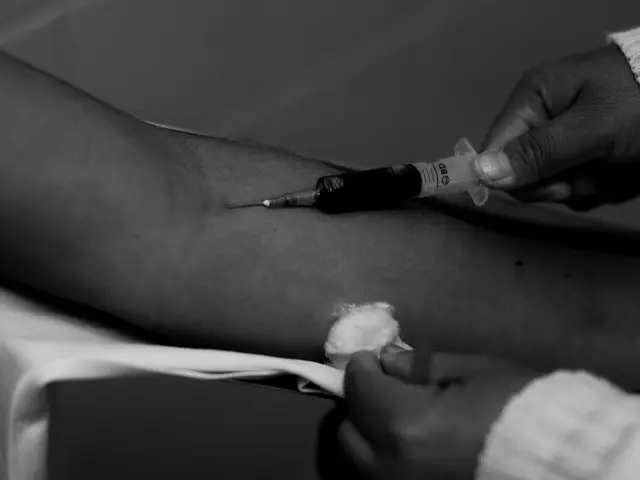Significance of Variety in Eczema Medical Research Studies
In the realm of dermatology, the significance of diverse representation in clinical trials is becoming increasingly apparent, particularly in the case of atopic dermatitis (eczema). This chronic, inflammatory skin disorder affects people of all skin tones, but the disease can present differently across racial and ethnic groups, complicating accurate diagnosis and treatment.
Atopic dermatitis in darker skin tones often exhibits less obvious redness and more subtle signs such as hypopigmentation, discoloration, thickening, or lichenification of the skin. These differences can lead to underdiagnosis or misdiagnosis if clinical trials and diagnostic criteria are primarily based on lighter skin presentations.
Including diverse skin tones in clinical trials ensures that treatments are tested for efficacy and safety in populations with different presentations and skin biology. This is crucial because skin of color may respond differently to therapies and may require tailored approaches. For instance, the drug lebrikizumab (Ebgyss) was specifically studied in participants with skin of color, demonstrating significant improvements in eczema severity and itch.
Moreover, representation supports culturally relevant care, which addresses broader barriers such as socioeconomic factors, access to care, language, and cultural trust, all of which influence treatment adherence and outcomes in people with skin of color.
Without adequate representation, patients with darker skin tones risk delayed diagnosis, ineffective treatment, and worse long-term outcomes. Efforts are being made to address this issue. The American College of Allergy, Asthma, and Immunology, along with the Allergy and Asthma Network, have created a website to help recognise the symptoms of eczema in skin of color. The National Institutes of Health (NIH) and the Food and Drug Administration (FDA) are also working to increase diversity in clinical trial participants for atopic dermatitis research.
It is worth noting that people with skin of color are more likely to develop atopic dermatitis than those with white skin, especially multiracial adults and Black children. Studies comparing the efficacy of eczema treatment in different racial and ethnic groups are lacking, but one study found that improvements in eczema symptoms with crisaborole were similar when comparing white and non-white participants overall, but less significant when examining specific racial and ethnic groups.
In conclusion, representation in clinical trials:
- Improves diagnostic accuracy by capturing the range of eczema presentations across skin tones.
- Enables development of effective treatments validated in diverse populations.
- Supports culturally relevant care, helping overcome systemic and social healthcare disparities.
- Leads to better patient outcomes through personalized and informed management approaches.
As we strive for a more inclusive approach in dermatology research, it is essential to acknowledge and address the challenges faced by those with darker skin tones in the diagnosis and treatment of atopic dermatitis. By fostering diversity and inclusion, we can work towards improving the quality of life for all individuals affected by this condition.
References:
[1] American Academy of Dermatology. (2020). Atopic dermatitis in skin of color. [online] Available at: https://www.aad.org/public/diseases/eczema/atopic-dermatitis-in-skin-of-color
[2] National Eczema Association. (2021). Diversity and atopic dermatitis. [online] Available at: https://nationaleczema.org/learn/diversity-and-atopic-dermatitis/
[3] National Eczema Association. (2021). Underrepresentation of people with darker skin in studies of atopic dermatitis. [online] Available at: https://nationaleczema.org/learn/underrepresentation-of-people-with-darker-skin-in-studies-of-atopic-dermatitis/
[4] American Academy of Dermatology. (2020). The role of dermatologists in addressing health disparities. [online] Available at: https://www.aad.org/media/news-releases/the-role-of-dermatologists-in-addressing-health-disparities
- The significance of inclusive representation in clinical trials is underscored in the field of dermatology, specifically for atopic dermatitis (eczema), a condition that affects individuals of various skin tones.
- The presentation of atopic dermatitis can vary significantly across racial and ethnic groups, making accurate diagnosis and effective treatment challenging.
- Lebrikizumab (Ebgyss), a drug for eczema, demonstrated significant improvements in symptoms in participants with skin of color, highlighting the importance of tailored approaches.
- Beyond treatment efficacy, representation supports culturally relevant care, which addresses various factors like socioeconomic status, access to care, language, and cultural trust.
- People with skin of color are more likely to develop atopic dermatitis, as seen in multiracial adults and Black children, yet studies comparing eczema treatment efficacy in different groups are underrepresented.
- In a study comparing white and non-white eczema patients, improvements in symptoms with crisaborole were generally similar, but less significant when examining specific racial and ethnic groups.
- Diverse representation in clinical trials empowers improved diagnostic accuracy, the development of validated treatments for various populations, and enables more informed management strategies.
- By fostering diversity and inclusion in dermatology research, we can address healthcare disparities and ultimately improve the quality of life for all individuals affected by atopic dermatitis.
- Efforts are being made to increase representation in clinical trials, with organizations like the American College of Allergy, Asthma, and Immunology, the Allergy and Asthma Network, the National Institutes of Health (NIH), and the Food and Drug Administration (FDA) all contributing to this cause.




